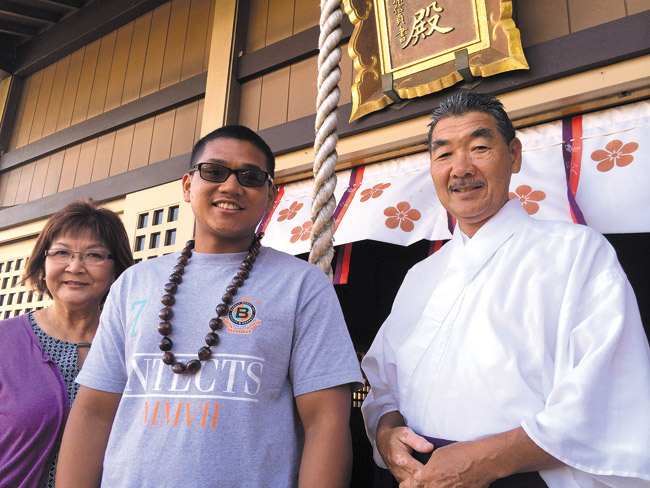Shinto Shrine Bridges Differences

Melvin Monces (center) with Diane Nishida, a member of the Kotohira Jinsha shrine’s board and scholarship committee, and Rev. Masa Takizawa | Photo from Melvin Monces
Kotohira Jinsha-Hawaii Dazaifu Tenmangu (hereafter Kotohira Jinsha) is a Shinto shrine. And despite its long, awkward-sounding foreign name, it is an active shrine that enjoys a notable tradition of interacting with the local community.
Every New Year’s Day, for example, more than 10,000 people visit the shrine for blessings, food, and the purchase of good luck charms.
More people than that drive by the shrine each day, as it sits alongside the eastbound lanes of the freeway between Farrington High School and Liliha. And depending on the afternoon traffic, if you are lucky you can set your camera to time-lapse mode and capture the sunset behind the shrine as your car crawls by.
Many also stop in at Kotohira Jinsha on a regular basis, as the shrine has ties to a dance academy, martial arts school and preschool.
At Kotohira Jinsha, one’s religious beliefs or cultural background doesn’t matter – gratitude for life and respect for tradition are enough. The tradition cultivated at Kotohira Jinsha is in good hands, as it is nurtured and guided by Rev. Masa Takizawa and his wife Irene.
Preserving tradition is not easy, though, especially when attempts are made to forcibly take it away. Just after the Second World War, the federal government raided the shrine, seized its property, and put it up for sale. Anti-Japanese sentiments were still strong then. However, the shrine challenged these actions, and Kotohira Jinsha became the first Japanese-based organization to successfully bring a lawsuit against the United States. Its property and tradition were returned, though it lost two-thirds of its property again in 1957 to make room for the Lunalilo Freeway.
Kotohira Jinsha is actually a collection of smaller shrines, one of which – Tenmangu – is traditionally dedicated to education.
To perpetuate this connection, the shrine holds a Back-to-School Education Blessing for all students in August, graciously hosts students visiting on field trips, and recently began to offer a scholarship to deserving students studying religion at Leeward Community College. Melvin Monces was this year’s recipient.
Melvin’s father passed away when Melvin was in the third grade. Apolinario Monces had worked at Hawaiian Commercial and Sugar Co. on Maui, where he was good friends with a fellow plantation worker, a Japanese man named Kyle Tokunaga. As an expression of their friendship, every December Mr. Tokunaga gave Melvin’s dad a kadomatsu-a bamboo, pine and plum blossom display tied together with straw rope that is placed outside the door of a home as a symbol of good luck – as a wish for health and prosperity for Melvin’s family.
His mother Maria continued to place a kadomatsu in front of their house even after her husband and his plantation friend passed away, as a reminder of the friendship the two men shared that bridged ethnic, religious and cultural differences.
Growing up, Melvin did not bother to ask about the yearly decorative display, as it was simply one of several traditions his mother kept. In his study of religion however, Melvin began to understand the significance of the kadomatsu and appreciate the meaning it had in Japanese culture, and now for his family tradition as well. One tradition became a path for understanding another.
Soon he began to find examples of common themes found in both Japanese and Filipino cultures. Melvin shared these findings with me, and I suggested two possible explanations for this:
Either certain values are universal in nature and are therefore shared by different cultural traditions, or Filipinos are really Japanese in disguise, and vice versa.
In honor of the tradition of friendship that Melvin’s father and his friend shared, and that Melvin’s mother preserved – which Melvin now inherits – Hawaii Kotohira Jinsha-Hawaii Dazaifu Tenmangu awarded its educational scholarship to Melvin last month.
Gratitude can arise from different sources, and traditions can be created anew. And sometimes traditions are worth preserving and celebrating, even if they were not originally your own.
misfitspirit808@gmail.com





